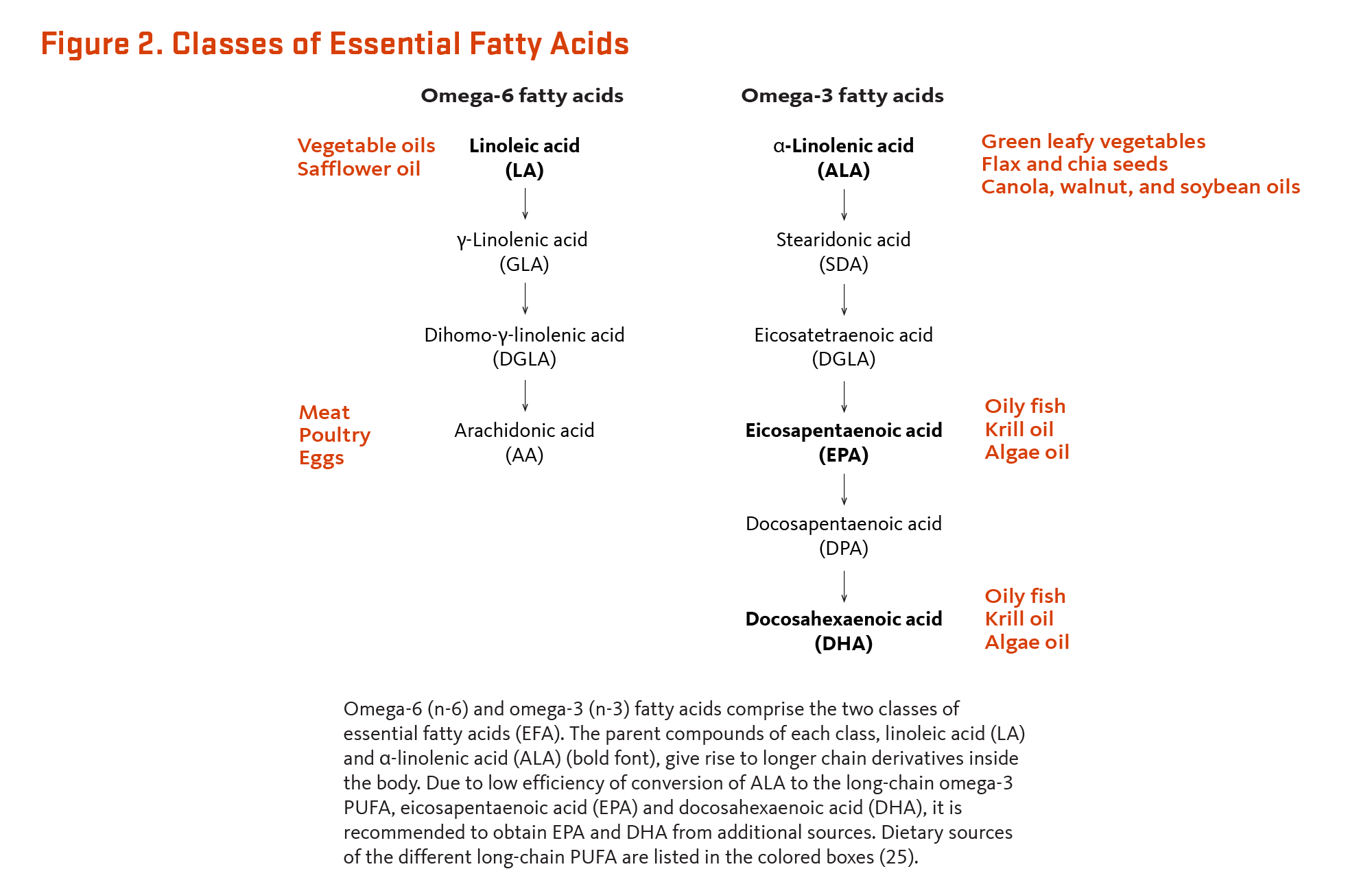Dear Osa friends,
TBE is back to, well, essentials this week with a look at omega-3 and omega-6 fatty acids and a lesser known function of these essential fats: activation of the endocannabinoid system. This fascinating internal “feel good” system impacts diverse physiological and mental functions including mood, pain sensation, inflammation, and appetite. Research shows that the balance of omega-3 and omega-6 fatty acids in our diet plays an important role in the functioning of the endocannabinoid system. We’ll dig into this and send you away with some action items too. I hope you enjoy!
What Are Essential Fats?
The root of the word “essential” is the Latin “essentia,” meaning “being”. In nutrition, we use the word essential to denote those nutrients that we need to obtain from our food. So, when read in the context of the meaning of this word, essential nutrients are the epitomy of “you are what you eat”.
Among the most important of essential nutrients are two fats (aka “fatty acids”): the omega-3 alpha-linolenic acid (ALA) and the omega-6 linoleic acid (LA). We obtain these from our diet: seeds like sunflower and hemp seeds, some nuts such as walnuts and cashews, and eggs are good whole food sources of LA. Interestingly, some of these foods, including walnuts and hemp seeds, are also good sources of alpha-linolenic acid, as are flaxseeds, chia seeds, and (to a much lesser extent) leafy green vegetables. In our bodies, these essential fats can be converted to longer chain fats that are absolutely crucial components of our cellular membranes. Here is a chart that shows the conversion of the essential fats to arachidonic acid, EPA, and DHA:

Because the conversion of ALA to DHA and EPA has been found to be quite low, consuming the longer chain omega-3 fats DHA and EPA is a common recommendation. Women who are in the 40 and better category (🙋) should take note that their natural conversion of ALA to DHA and EPA is aided by estrogen, and declining estrogen levels as we age mean that we need to be extra mindful of our DHA consumption in particular1. Fish is of course the most well known source of these longer chain omega-3 fats; however, algae is increasingly being recognized as an alternative source which is additionally vegan and potentially more sustainable.
What Are the Functions of Essential Fats?
Omega-3 and omega-6 fatty acids have pleitropic effects throughout the body which derive from their ubiquitous presence in the membrane of every cell, where they are best known for their roles in instigating and resolving inflammation. Generally speaking, the omega-6 fatty acids are known to promote inflammatory processes while omega-3 fatty acids help to resolve inflammation–although there is overlap in these functions as well.
Please note that both inflammation and resolution of inflammation are essential processes! Without inflammation, we have no defense against infections and no wound repair. Without resolution of inflammation, we have chronic pain, cellular dysfunction, and tissue degeneration. We need both types of essential fats. While the optimal ratio is a matter of debate, typical recommendations range from a 2:1 to a 4:1 ratio of omega-6:omega-3 fatty acids.
Ok, so what does this have to do with cannabinoids?? Let’s get to it.
Endocannabinoids: Your Feel Good System
Everyone is at least somewhat familiar with the term “cannabinoid” as a constituent of cannabis, but did you know that your body makes its very own cannabinoids?🤯 These are called endocannabinoids, and they have an array of interesting modulatory functions in the brain, in immune cells, and in muscle and fat cells too, regulating mood, inflammation, and appetite in a way that keeps things relatively calm and in check–or to use a more technical term, they help maintain homeostasis.
What does this have to do with fatty acids? Endocannabinoids are derived from essential fatty acids, so the balance of essential fatty acids in your body has an impact on the functioning of your endocannabinoid system and, consequently, an impact on your neurological, immune, and metabolic health as well.
Omega-3 vs. Omega-6 cannabinoids
The most well studied endocannabinoids are are derivatives of arachidonic acid, an omega-6 fatty acid; however, there are also endocannabinoids that are derived from the omega-3 fatty acids, DHA and EPA. Much like how a balance between omega-3 and omega-6 fatty acids facilitates a healthy and controlled inflammatory response, research shows that this same balance of omega-3 and omega-6 fatty acids is also needed for an optimally functioning endocannabinoid system2.
More specifically, when our essential fatty acid balance is tipped too far toward omega-6 fats, this can activate our endocannabinoid system in an undesirable way that increases appetite, fat cell size, and even anxiety. Let’s look at a few studies which illustrate this.
Diving Into the Research
One preclinical study found that a low-fat diet enriched with LA (omega-6 lineoleic acid) led to increased circulating omega-6-derived cannabinoids and a parallel increase in weight gain and in fat cell size, compared to a diet supplying the same amount of calories but much lower in linoleic acid.3 This is likely due to the preference of omega-6 endocannabinoids to bind specific receptors (called CB1 receptors) in fat tissue. In contrast, omega-3 fats may increase cannabinoid receptors in muscle, where they encourage glucose uptake.4
Now, we definitely like glucose uptake into muscle–this is our body’s primary mechanism of regulating blood sugar.
The relationship between our muscle and glucose is somewhat akin to the relationship between trees and carbon. Trees act as “carbon sinks” for the earth, trapping the carbon dioxide that would otherwise act as a greenhouse gas, damaging the earth’s ecosystems. Likewise, we can think of our muscles as “glucose sinks” for the body. They trap any excess glucose floating around, stopping it from clinging to and damaging tissues such as your blood vessels, or from overloading your mitochondria, which can result in excessive production of deleterious reactive species that also damage tissues.
(And while we’re talking about muscle, don’t forget that omega-3 fatty acids are great for your muscle health too–check out the article I wrote on that topic).
Interestingly, due to what was discovered about CB1 receptors and fat cells, blocking this specific subset of receptors has been researched as a weight reduction measure; however, preliminary clincial trials have been stopped in the past due to dangerous side effects including depression and suicidal ideation, although research continues into use of CB1 antagonists for obesity and addiction.5
In terms of mental health, preclinical research has also shown that omega-3 fatty acid deficiency results in anxious behavior which was found to be related to impaired cannabinoid receptor function in the brain.6
Actionable Info
In summary, research into the endocannbinoid system supports consuming a diet balanced in quality omega-3 and omega-6 fatty acids for both appetite control and mood. When appetite and mood concerns are already present, it makes sense to lean in to omega-3 fatty acids and to be mindful of our omega-6 intake. Again, the ratio we are shooting for lies somewhere in the 2:1 to 4:1 ratio of omega-6: omega-3 fats. Omega-6 fats tend to be more plentiful in the modern diet, whereas omega-3 fats are more sparse; this is another reason why it is helpful to be especially mindful of our omega-3s.
So what does leaning into omega-3 fats look like? Here at some ideas: fatty fish like sardines, mackerel, anchovies, or wild salmon a few times a week, hemp and flax seeds daily, leafy green salads topped with chopped walnuts, grass-fed meat and dairy, eggs from pastured chickens, and a high quality DHA/EPA supplement.*
If you really want to know what your essential fatty acid quantity and balance is, I utilize micronutrient testing from functional lab providers like Genova, Spectracell, and Vibrant to provide clients with specific insights about their essential fatty acid balance (and many many more micronutrients!). As we’ve talked about previously, this kind of personal data can be just the fuel you need for lifestyle change that works for you.
Do you have questions about this topic, or have another topic that you’re curious about? Please send me an email! And as always, if this resonated with you, thank you in advance for sharing with a friend, family member, or colleague.
Wishing you a beautiful day,

References
- Giltay, E. J., Gooren, L. J., Toorians, A. W., Katan, M. B., & Zock, P. L. (2004). Docosahexaenoic acid concentrations are higher in women than in men because of estrogenic effects. The American journal of clinical nutrition, 80(5), 1167–1174. https://doi.org/10.1093/ajcn/80.5.1167 https://pubmed.ncbi.nlm.nih.gov/15531662/
- Bosch-Bouju, C., & Layé, S. (2016). Dietary Omega-6/Omega-3 and Endocannabinoids: Implications for Brain Health and Diseases. InTech. doi: 10.5772/62498 https://www.intechopen.com/chapters/50397
- Alvheim, A. R., Torstensen, B. E., Lin, Y. H., Lillefosse, H. H., Lock, E. J., Madsen, L., Frøyland, L., Hibbeln, J. R., & Malde, M. K. (2014). Dietary linoleic acid elevates the endocannabinoids 2-AG and anandamide and promotes weight gain in mice fed a low fat diet. Lipids, 49(1), 59–69. https://doi.org/10.1007/s11745-013-3842-y https://pubmed.ncbi.nlm.nih.gov/24081493/
- Kim, J., Carlson, M. E., Kuchel, G. A., Newman, J. W., & Watkins, B. A. (2016). Dietary DHA reduces downstream endocannabinoid and inflammatory gene expression and epididymal fat mass while improving aspects of glucose use in muscle in C57BL/6J mice. International journal of obesity (2005), 40(1), 129–137. https://doi.org/10.1038/ijo.2015.135 https://pubmed.ncbi.nlm.nih.gov/26219414/
- Soler-Cedeño, O., Alton, H., Bi, GH. et al. AM6527, a neutral CB1 receptor antagonist, suppresses opioid taking and seeking, as well as cocaine seeking in rodents without aversive effects. Neuropsychopharmacol. 49, 1678–1688 (2024). https://doi.org/10.1038/s41386-024-01861-y https://www.nature.com/articles/s41386-024-01861-y
- Larrieu, T., Madore, C., Joffre, C., & Layé, S. (2012). Nutritional n-3 polyunsaturated fatty acids deficiency alters cannabinoid receptor signaling pathway in the brain and associated anxiety-like behavior in mice. Journal of physiology and biochemistry, 68(4), 671–681. https://doi.org/10.1007/s13105-012-0179-6 https://pubmed.ncbi.nlm.nih.gov/22707188/
*Disclaimer: This does not constitute medical advice and is for general informational purposes only. Please consult with your healthcare provider to determine whether diet or supplement changes are right for you.
Photo credit: Canva
